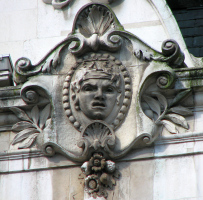
Allegorical statues of Tragedy are typically linked with Comedy, as a pair associated with theatres and playhouses of the Victorian and above all the Edwardian period. Tragedy can also be found on her own, as a tragic figure.
Let us look at Theatrical Tragedy first. The example below left is typical of the breed. Our allegorical figure of Tragedy is female here, as is normally the case, stern of face, and her pose, if not stiff, is at least rather formal than relaxed. In this example she is not remotely muscular – look at the bare arms – but her neck is rather thick, which combined with her long and rather unruly hair gives her something of the aspect of a warrior. She holds in her hand the Tragic Mask, which here looks to be more of a face than a mask, as if she is some Judith holding the decapitated head of Holofernes. The mouth of this face is stretched wide open and somewhat down at the sides, as if in a cry of woe, and this expression is taken from the standard Classical Greek tragic mask.
To the right, we have the equivalent figure of Comedy, not at all the subject of this page, but to note here with the excuse of the contrast it offers. Allegorical Comedy feels more youthful than allegorical Tragedy. She has a half smile upon her face, and her shorter-cut hair is filled with leaves and flowers to give a hint of the bacchanalian revel, She is somewhat in a state of jolly undress, again giving the idea of the Bacchic, pagan festival, unlike Tragedy, who is fully draped. Her pose is more relaxed. She too holds a mask, and the mask of Comedy has a rather absurd, silly expression, for Comedy is slapstick, unlike portentious and significant Tragedy.

 Tragedy contrasted with Comedy.
Tragedy contrasted with Comedy.
Our next example, below left, high up on a building, in battered ceramic, shows some of the same characteristics. She is again grim of face, fully draped, with a wrap around her head and over her shoulders too, and has the Tragic mask, perhaps hanging from some unseen belt, against her waist. Again we see the wide, downturned mouth, and this is definitely a mask rather than a severed head. In her other hand she carries a slender dagger, for this is not just any allegorical figure of Tragedy, but a statue of Lady Macbeth, about to commit ugly murder, and her face already showing her troubled mind. The Tragic figure below right is remarkable for the size of her mask, rather grotesque, with great gaping mouth, shield shaped face, and grim, staring eyes – a disturbing image. Again we note the sober pose, the full drapes, and in this case a strictness imbued by her hair tied up in a bun.
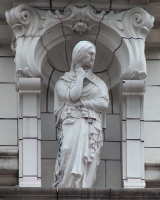
 Tragedy as Lady Macbeth, and with grotesque mask.
Tragedy as Lady Macbeth, and with grotesque mask.
We return to Shakespeare in the panel below left, where we see the actual Bard standing centre, lounging against a pillar, legs crossed in a casual 19th Century girl-with-a-funeral-urn pose. He is conversing with our allegorical figure of Tragedy, who here is seated. We recognise her by the Tragic mask, and we note too the serious expression, full drapes, and tied back hair. A small symbol of Comedy is shown in the cross legged putti on top of the pillar behind her. The scene is from the Oxford and Cambridge Club in Pall Mall, and the sculptor was W. G. Nicholl. Below centre we have another seated Tragedy statue, a small sweet creature in the Arts and Crafts idiom on the W. S. Gilbert Memorial on the Victoria Embankment, the inspiration of the sculptor George Frampton. She is grave of face without frowning, with a less formal pose than usual, but a certain stillness of motion, despite her pen in hand. Her other hand stretches out offering a flower to the deceased playwright, not the usual accoutrement but appropriate given this is a funereal monument. Below right, we have a further seated allegorical figure of Tragedy, seen rather obliquely in a pediment from far below. This rather nice example has the recognisable dress – we note how often the dress falls to the feet, but the arms are bare – and the mask with a wide-stretched mouth. She also carries a dagger, but with no particular reference to a specific heroine or anti-heroine of literature.
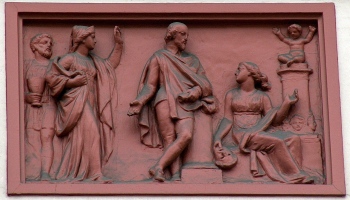
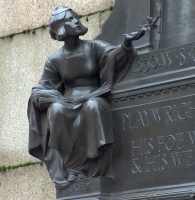
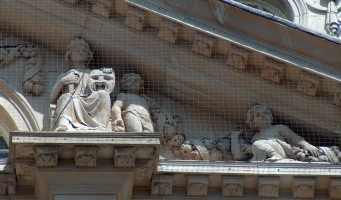 London statues of Theatrical Tragedy.
London statues of Theatrical Tragedy.
Returning to the theme of Theatrical Tragedy, I wanted to include an example of Tragedy and Comedy embodied in a single figure. Here, on another funereal monument, we have such a figure, with masks of both beside her. The allegorical figure embodies Tragedy though, as we would expect in a memorial, with her fully draped figure, head leaning sadly on her arm, and veiled hair, and the guttering torch on the floor. Below right is another figure entitled Tragedy and Comedy, rather unusual both in being male and in being entirely nude; he is however holding the Tragic mask with gaping mouth.
We may also note that the Tragic mask on its own may be found as a shorthand emblem, as in the Theatre facade below, with alternate Tragic and Comedic masks separated by festoons of flowers. Particularly strange mouths on these figures, which however emphasise a common feature of such masks, taken very much from the ancient Greek, which is the great breadth to height of the face, effectively filling a square frame. The example at the top of this page on a cartouche is a face rather than a mask, with the frown and the mouth being the characteristic features.
Tragic and Comedic masks in architectural setting.
A rather grim pair of Tragedy enveloping Comedy is below left, not theatrical, but emblematic of the passage of time. The girl on the left, young, nude and beautiful, would seem to be the Comedy of happy youth. Next to her, the stern figure of Tragedy, a figure of Death, reaches her hand round to enfold and cut down the carefree girl in her youthfulness. No mask of course, but we have familiar grim-faced visage, constrained hair, formal pose, and long dress. The work of Bertram Mackennal. Also by Mackennal is the figure below right, another allegorical statue of Tragedy, very sad, her cloak and cowl wound around her in the manner of ancient Tanagra pottery figures, her one hand clutching at the cloth suggestive of holding herself together in the face of great sorrow.
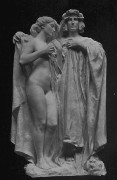
 Bertram Mackennal allegorical figures of Tragedy.
Bertram Mackennal allegorical figures of Tragedy.
We end with an example of a free-standing figure of Theatrical Tragedy, but without a mask. Her drapes again owe something to Tanagra, and we see her as a Lady Macbeth figure, clutching her knife close to her body as if she has just brought it out from concealment to ready herself to strike the fatal blow.
Back to Allegorical sculpture - S // Onward to Allegorical sculpture - U // Full Alphabet of Allegorical sculpture
Sculpture in London // Sculpture in England // Sculptors
Visits to this page from 16 March 2013: 11,071